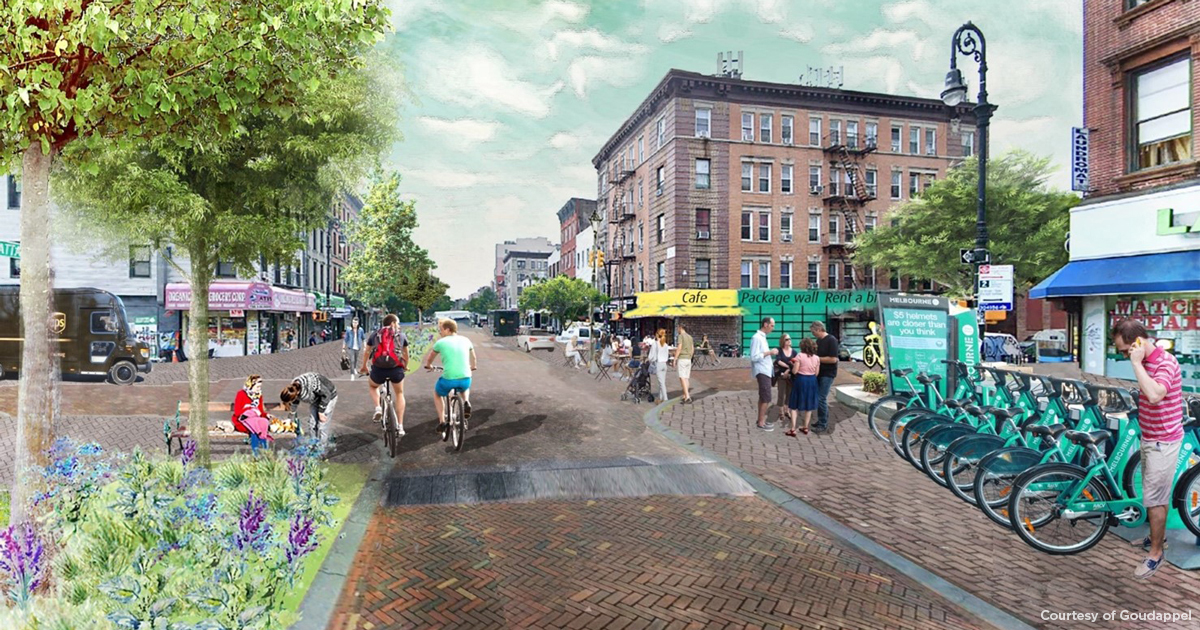Forward-thinking insights focused on a more sustainable tomorrow.
Curb Management: Creating Livable Streets Using Mobility Planning
Introduction
Sidewalks and streets are the largest publicly owned spaces and there has always been a tremendous amount of competition for curb and sidewalk usage. The use of the public space as it pertains to curb management has continued to evolve as urban environments aim to create livable streets. With initiatives to improve quality of life, climate adaptability, safety, and sustainability, and an impetus to give space back to people, this is a transformative time for communities to step back and re-envision mobility in a post-pandemic world. These issues are ubiquitous—in the U.S. and in the Netherlands, and elsewhere.
Summary
VHB and Goudappel are partnering on an initiative to explore the vision for curb and sidewalk usage over the next 5, 10, 15, and 20+ years. This initiative aims to engage Departments of Transportation and local municipalities in a conversation that is much broader than a single area or city. We are proposing a new mindset, a way of thinking, an idea that is practical and transferable (fully or partially) to any geography and enables the governing agency to create a vision for their community. The COVID-19 pandemic served as a catalyst in advancing some changes, but the fundamental questions remain—will this temporary mindset become permanent, or will things return to “business as usual”?

VHB and Goudappel brought together partners across various cities from the U.S. and the Netherlands to discuss experiences and results based on recently implemented solutions to improve livability. Perspectives, challenges, and outcomes for creating livable streets using mobility planning were provided by a panel of industry leaders.
- Frans Botma, Policy Advisor for Public Space, City of The Hague (Netherlands)
- Chris Hrones, Director of Transit Planning & Policy, New York City Department of Transportation (NYCDOT)
- Martin Guit, Urban Planning City Mobility, City of Rotterdam (Netherlands)
- Shayna Pollock, Managing Director, Transportation, Central Atlanta Progress
Key Takeaways & Common Themes
Panelists represented cities of varied size, population, and locale—in two different countries. Common themes emerged regarding challenges and potential solutions. Key insights and takeaways shared during the conversation included:
Safety is a big catalyst.
Several panelists cited their city’s desire for improved safety as a catalyst for examining—and evolving—curb management and generally agreed that speed reduction is needed for safety improvement. Use of brick roadways instead of asphalt can help reduce speed, while separated bike lanes can protect vulnerable road users. Many cities are also implementing Vision Zero programs, which aim to eliminate all traffic fatalities and severe injuries, while increasing safe, healthy, equitable mobility for all.
Climate change is spurring innovation.
With CO2 from vehicles a major contributor to pollution and climate change, communities are exploring ways to reduce single occupancy vehicle use. This includes alternate modes of transportation (biking, walking, transit) for trips less than five miles. Adapting to hotter weather and increased precipitation from climate change is also driving the need for green streets, including grass, plants, and trees to absorb rain and provide shade. In Rotterdam, where they now have more people on bikes than in cars in the city center, the focus is on healthy and clean mobility, and giving space back to the people.
A people-first approach is imperative.
Panelists agreed that it is time to change mobility behavior and put humans—not vehicles—first. This includes not only prioritizing pedestrians and bicyclists during planning and design, but also incorporating robust public engagement that uncovers what options work best for each unique community. Adjusting traffic circulation patterns, permanently closing streets, and limiting on-street parking to one side only are all options that prioritize people and encourage healthy mobility. In The Hague, a new traffic circulation pattern diverted through traffic as part of a complete streets program, which saw a reduction in accidents, an increase in bicycle users, and new business.
Mobility transformation is about balance.
While automobiles are here to stay in one form or another (e.g., electric vehicles, autonomous vehicles), we need to re-balance mobility. As an example, separated bike lanes allow for another transportation mode choice; however, they also result in less curb space for other purposes and a loss of on-street parking. Each community must determine which options work best for their residents, businesses, visitors, and commuters. In New York City, the DOT is working with businesses to encourage use of cargo bikes to reduce delivery vehicles and installing corrals specifically designed for them. Shared streets provide opportunity to integrate multiple modes of transport, while rail and transit allow for regional connectivity.
There is no cookie cutter solution.
In a post-pandemic world, curb management has evolved to include many competing uses. On-street parking (for cars and bikes), loading zones, bus stops, delivery access, trash pick-up, outdoor dining, green space, ride hailing, and storage are all vying for the same limited space. What works in one community may not work in another, but we can learn from each other and pilot programs, which even when not successful provide valuable lessons learned. In Atlanta, the Peachtree Shared Street Case Study revealed that, while a people-first approach is important, we cannot lose sight of other curb needs. Leveraging technology to capture and analyze data can help align curb priorities with a city’s goals and budget.
A long-term vision is needed.
Changing technology and evolving community needs require that we continue to explore new uses and priorities for curbs. We need to consider not only today’s population, but what communities might look like in five, 10, 20, even 50 years from now. Regional investments allow for broader solutions and better connectivity and accessibility for a larger user population.
Streets are our single largest public space. Making our streets, sidewalks, and curbs safe, diverse, and inviting places will transform mobility, spur economic development, and create more sustainable communities.
About VHB
Headquartered in Watertown, Massachusetts, VHB delivers technology-enabled solutions that reimagine the built environment to shape more sustainable, equitable, and resilient communities. Our diverse team of engineers, scientists, planners, and designers brings together collective knowledge, technical excellence, and a wide network of trusted relationships to address our clients’ most complex challenges. VHB’s work across the East Coast helps improve mobility, enhance communities, build resilience, and contribute to economic vitality. Learn more about VHB.
About Goudappel
Goudappel is the leading firm in mobility planning in the Netherlands. We cover all areas of expertise, and can provide our clients with full-service advice. Our consultancy work is based on high-quality data and an in-depth knowledge of mobility, using software and models that we develop in house. As a committed mobility expert, we offer our clients insight and action perspectives. In this way, we jointly create a better living environment for everyone and contribute to increasing the broad-based prosperity of society. Learn more about Goudappel.




